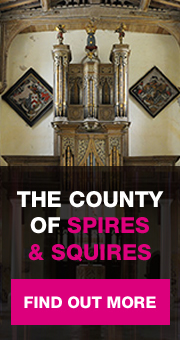Well done if you have found it! The church is tucked away in the estate village that lies behind Courteenhall Hall. If that was not enough, the M1 sealed its remoteness cutting it off from Northampton.
It has all the hallmarks of an estate church – built and improved by the families who lived in the hall and here they found their final resting place.
Courteenhall was originally owned by St James’ Abbey in Northampton. It was acquired by Richard Ouseley who built a large mansion here in 1572. His is a large tomb chest topped with brasses that is now tucked away behind the organ. Note the witty inscription that refers to his two wives – A Miss Partridge and Miss Wake.
Nearby the black and white marble tomb is to his successor, Sir Samuel Jones and his wife Mary. This is attributed to the London sculptor John Stanton. Jones had acquired the estate in 1647 and the aisle windows and the village hall (formally the Grammar School) were paid for through his legacies.
The Jones’ were followed by their kinsman the Wakes (descendants of the famous Hereward the Wake – Terror of early Norman kings). The Wakes continue here today. It was the 10th Lady Wake’s relation. J.P St Aubyn who restored the church (1882-3).
The large walled tomb at the back to Sir Charles Wake Jones, 1st Bt. (1725-1755) is by the Northampton sculptor William Cox whose workshop was in Derngate – note the winged skull. Elsewhere a plethora of Wake wall tablets and one oddity, a porcelain memorial to the infant Iola Campbell (D. 1852).
As you leave you will pass by the hall designed by Samuel Saxon (1791-3), with its grounds by Humphrey Repton.
Please refer to the Glossary for any terms in the text that you are unfamiliar with.







